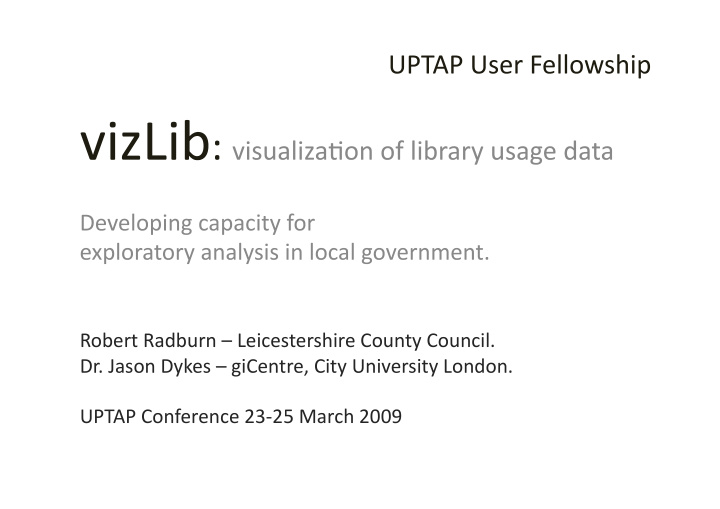



Robert Radburn – Leicestershire County Council. Dr. Jason Dykes – giCentre, City University London. UPTAP Conference 23‐25 March 2009
1. Context - Research & Information @ Leicestershire County Council
Leicestershire and me (and Jason)
Local authority research… • No interpretaNon of the data or highlighNng of key problems. • Data presentaNon is very formulaic. • Maps do not generally convey any useful informaNon. Post Audit Review, 2001 CriNcisms and weaknesses of the 2001 Leicestershire crime and disorder audits. Holden MacAllister Partnership, 2002
The “before” picture
The “aTer” picture
The government now demands councils to have a deeper understanding of ciNzens. How safe is an area? How healthy and well supported are people? How well is housing need met? How strong is the local economy? How well is inequality being addressed? How good is the well‐being of children and young people?
2. Rationale: Why Libraries?
Although popular their future is constantly debated Wri$ng on the Wall Guardian, Leader ‐ 20 October 2008 . “Libraries are closing ‐ 75 last year – and individual visits are in steady and apparently inexorable decline The only hope lies in revoluNon…”
Libraries tradiNonally understand users by producing a community profile… “…if your community profile shows that you have a large number of unemployed people or people over 65 years old in your community this will probably affect the type of services you offer.” How to… Develop a Community Profile: A guide for museums, libraries and archives Museums, Libraries and Archive Council
...but knowing about your users is different from understanding how they use the service… 1. Who are the best customers using the library service? How is that changing? Which areas are they living in? Can the area you live in contribute to predicNons of usage? 2. What are the various trigger points that predict when a customer starts, stops using a library, or changes their borrowing habits?
…and this requires using lots of customer data. 435,801 number of borrowers in Leicestershire 1 million records on loans each year. 25+ book categories 1,993 output areas in Leicestershire
InteracNve visualizaNons may provide the answers. Dykes, J A Unpublished work
3. UPTAP fellowship aims
The user fellowship has three phases. • Phase 1 : Skills development (Oct 08 to Jan 09) Milestone: skill‐set sufficient to develop prototype interacNve graphics data derived, checked, transformed, prepared and loaded into database. • Phase 2 : Visualiza$on (Jan 09 to May 09) Milestone: build a visualizaNon prototype. • Phase 3 : Communica$on (May 09 to July 09+) Milestone: compleNon of the communicaNon and user engagement plan and documentaNon of findings in UPTAP research findings series .
4. UPTAP Progress
Phase 1: Skills development (October 08 to January 09)
Phase 2: VisualizaNon for data analysis (January 09 to May 09)
5. Next steps and reflections
Next steps • work with library service to discover interesNng pagerns or trends. • finish the prototype, add OAC + survey data, look at doing another prototype. • phase 3: communicaNon Laria (next week), GISRUK(next week), Space Centre (Thursday!) organise naNonal library workshop.
UPTAP reflecNons • two jobs is hard going + difficult to always be working out of your comfort zone. • five months is not long. • many ‘other’ benefits to both organisaNons. • Finally, thanks for the opportunity.
Recommend
More recommend